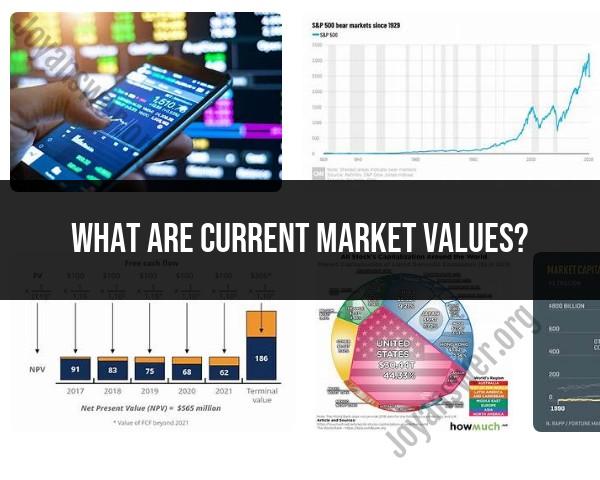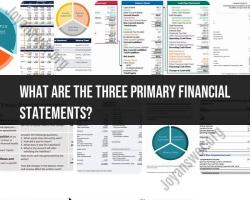What are current market values?
Current market values typically refer to the current prices or worth of financial instruments such as stocks, bonds, commodities, or other assets traded in financial markets. These values are determined by market forces like supply and demand and are reflected in various financial indices.
Stock Market Values:
- Stock Prices: The current value of a stock represents the price at which it is currently trading on the stock exchange.
- Stock Indices: Indices like the S&P 500, Dow Jones Industrial Average (DJIA), or NASDAQ Composite Index provide a snapshot of the overall stock market performance by tracking the combined values of a selection of stocks.
Bond Market Values:
- Bond Prices: The value of a bond is reflected in its current price in the bond market. It can fluctuate based on interest rates, credit ratings, and market conditions.
- Bond Indices: Bond market indices, such as the Bloomberg Barclays U.S. Aggregate Bond Index, track the performance of a basket of bonds and reflect changes in their values.
Commodity Market Values:
- Commodity Prices: The current value of commodities like gold, oil, agricultural products, etc., represents their current market prices and is subject to supply, demand, geopolitical factors, and market speculation.
- Commodity Indices: Indices like the CRB Index or Bloomberg Commodity Index track the performance of a selection of commodities and reflect changes in their values collectively.
Cryptocurrency Market Values:
- Cryptocurrency Prices: The value of cryptocurrencies like Bitcoin, Ethereum, etc., is determined by market trading on cryptocurrency exchanges and is highly volatile due to market sentiment and adoption.
- Crypto Indices: Some indices track the performance of multiple cryptocurrencies to provide an overview of the crypto market's movements.
Real Estate Market Values:
- Property Prices: In the real estate market, property values indicate the current estimated worth of properties, influenced by location, market trends, economic conditions, and demand.
Understanding Market Values:
- Market Cap: For stocks, it's the total value of a company's outstanding shares, calculated by multiplying the current stock price by the number of outstanding shares.
- Market Indices: These indices offer a benchmark to measure the overall performance of different markets and sectors.
In essence, current market values represent the prevailing prices or worth of various financial assets at any given moment, playing a crucial role in investment decisions, portfolio management, and assessing overall market health.
Tracking Market Trends: Monitoring Economic Indicators and Industry Developments
In the dynamic world of finance, staying abreast of market trends is crucial for making informed investment decisions. This involves closely monitoring economic indicators and industry developments to identify emerging trends, anticipate potential shifts, and assess overall market conditions.
Key Strategies:
Monitor Economic Indicators: Keep a close eye on key economic indicators such as GDP growth, inflation rates, interest rates, and employment figures.
Analyze Industry Trends: Track industry-specific trends, including technological advancements, regulatory changes, and consumer behavior shifts.
Utilize Market Research Tools: Employ market research tools and reports to gain insights into industry trends, competitor activities, and emerging opportunities.
Engage with Financial Experts: Consult with financial experts and analysts to gather valuable perspectives on market trends and potential investment opportunities.
Assessing Asset Valuation: Evaluating the Current Worth of Various Investment Options
Accurately assessing the valuation of various investment options is essential for making prudent financial decisions. This involves analyzing fundamental and technical factors to determine the intrinsic value of an asset relative to its current market price.
Key Strategies:
Analyze Financial Statements: Scrutinize financial statements such as balance sheets, income statements, and cash flow statements to assess a company's financial health and performance.
Conduct Industry Analysis: Evaluate the competitive landscape, industry growth prospects, and potential risks associated with the specific industry or sector.
Consider Valuation Methods: Employ valuation methods such as discounted cash flow analysis, comparable company analysis, and precedent transaction analysis to determine an asset's intrinsic value.
Seek Professional Guidance: Consult with financial advisors or investment professionals for expert guidance on asset valuation and investment strategy.
Understanding Market Fluctuations: Navigating Risks and Seizing Opportunities in a Dynamic Market
Market fluctuations are an inherent aspect of the financial landscape, presenting both risks and opportunities for investors. Understanding the factors driving market movements and developing risk management strategies are crucial for navigating a dynamic market.
Key Strategies:
Identify Risk Factors: Recognize and assess the various risk factors that can impact market fluctuations, such as economic events, political instability, and geopolitical tensions.
Diversify Investment Portfolio: Diversify your investment portfolio across different asset classes, industries, and geographic regions to mitigate risks and enhance overall portfolio stability.
Establish Risk Tolerance: Determine your risk tolerance and tailor your investment strategy accordingly, aligning risk-taking with your financial goals and risk appetite.
Monitor Market Conditions Regularly: Continuously monitor market conditions, staying informed about emerging trends, potential disruptions, and economic developments.













